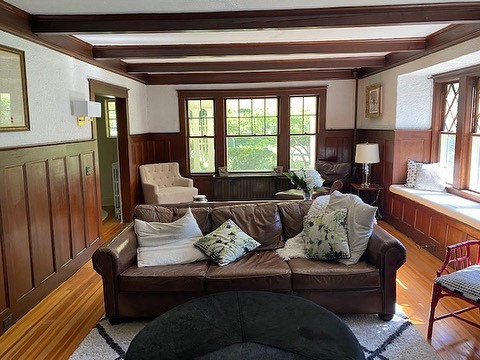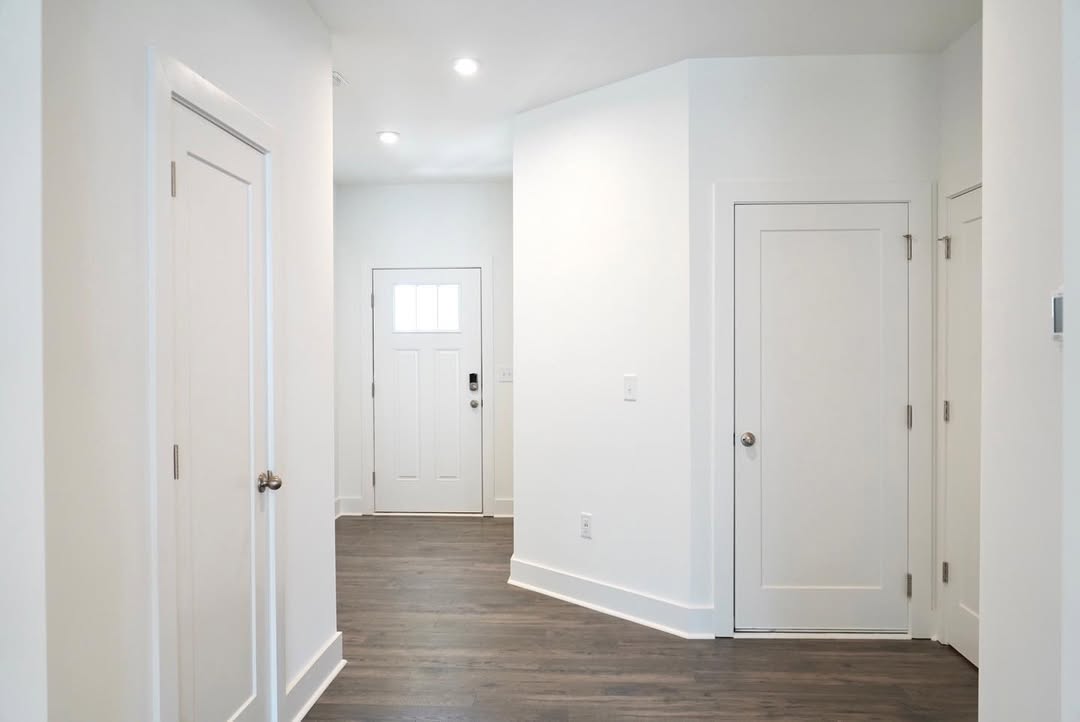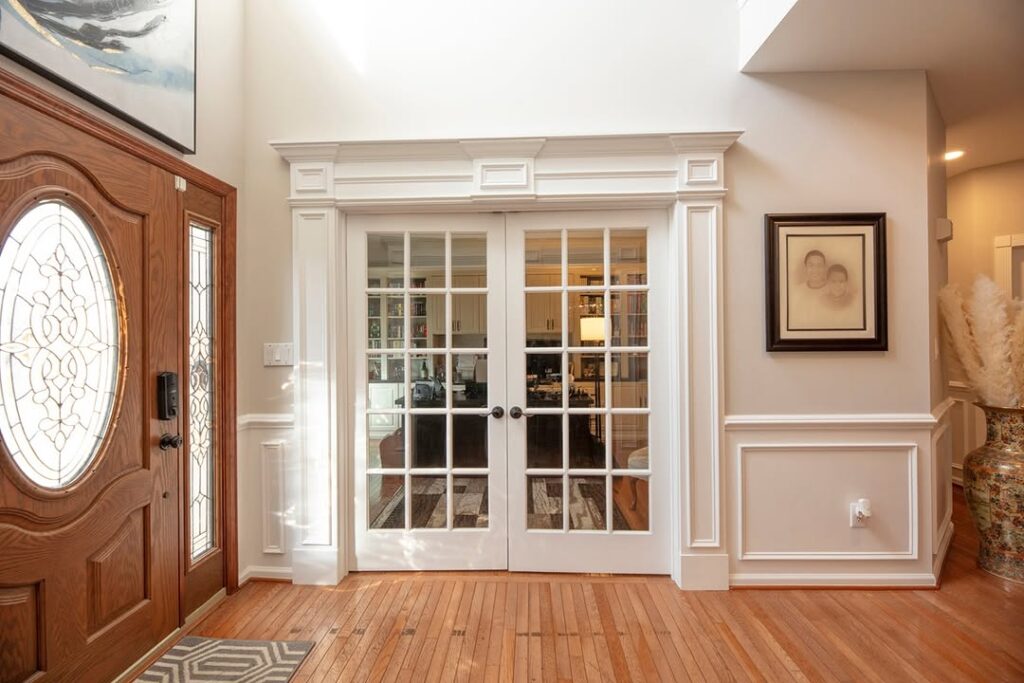In this blog, I’ll explain the differences between wood trim and white trim so you can make the right decision. Let’s examine how these two trims compare in terms of style, durability, and cost.
When deciding between wood and white trim, you might wonder which is right for your home. Should you go for wood’s natural, warm look, or is white trim’s crisp, clean appeal a better fit? I’ve been there, too, trying to choose the best trim for different rooms.
Both types of trim have unique benefits, but it’s important to consider your style, lifestyle, and maintenance needs. Are you drawn to a classic, rustic feel, or prefer something modern and fresh?
By the end, you’ll better understand which trim fits your home’s personality.
The Beauty of Wood Trim

When I first thought about wood trim, I wasn’t sure if it was the right choice. I imagined it might feel too old-fashioned. But the more I looked into it, the more I realized how much charm it brings to a home. Wood trim has a warmth that you can’t get with other materials. It feels rich, cozy, and natural.
If you love rustic or traditional styles, wood trim fits perfectly. The grain patterns and natural tones add depth to your space. Even in modern homes, wood trim can stand out beautifully. It creates a unique contrast when paired with white or light-colored walls.
Another thing I noticed is how versatile wood trim is. It works well with hardwood floors, stone accents, and neutral décor. It ties everything together in a way that feels balanced. Plus, it’s timeless. Trends come and go, but wood trim always stays stylish.
Wood trim is an excellent choice if you want your home to feel warm and inviting. It’s not just about looks, it adds character and makes your space feel special. I love that it’s both classic and adaptable. It’s like giving your home its personality.
Why Homeowners Love White Trim?

When decorating my home, I noticed how white trim made everything look brighter. It gave my rooms a clean and polished feel, almost like they belonged in a magazine. White trim is so simple, yet it makes everything else stand out.
One thing I love about white trim is how versatile it is. White trim works no matter the wall color bold, soft, or neutral. It’s like a blank canvas that ties the whole room together. It also highlights details like window frames or crown molding, making them pop.
White trim also makes rooms feel bigger. I used it in a small hallway, and it instantly felt more open. Plus, if it gets dirty or scuffed, it’s easy to fix with a quick coat of paint. That’s a massive win for high-traffic areas like kitchens and entryways.
White trim is a no-brainer if you want a fresh, modern look. It’s timeless, easy to maintain, and makes your home light and airy. For me, it’s the perfect choice when I want a simple but striking finish.
Comparing Wood Trim and White Trim

When choosing between wood trim and white trim, it’s essential to consider their unique qualities. Both options have advantages, but the right choice depends on your style, maintenance preferences, and the overall look you want to achieve. Let’s compare both trims to help you decide which best suits your home.
Aesthetic Appeal
When I think about wood trim, I picture warmth and natural beauty. It has this classic charm that makes a room feel cozy and grounded. The grain patterns are unique and bring so much character to your home.
Wood trim fits perfectly with rustic, craftsman, or even farmhouse styles. I love how it pairs beautifully with earthy tones and hardwood floors, creating a rich and inviting space.
On the other hand, white trim has its appeal. It’s clean, crisp, and incredibly versatile. I’ve used it in rooms where I wanted a bright and modern feel, and it always delivered.
White trim makes wall colors stand out, whether bold or soft. It’s also great for creating sharp lines and highlighting details like baseboards or window frames. While wood trim feels warm, white trim brings any room a fresh and airy vibe.
Maintenance
When it comes to wood trim, I’ve learned that keeping it looking good takes a bit of effort. You need to polish it now and then to maintain its shine. Dust and scratches can show up over time, so it’s essential to clean it carefully.
I’ve also noticed that wood trim doesn’t always do well in humid areas like bathrooms—it can warp if you’re not careful. While durable, it needs regular attention to stay at its best.
On the other hand, white trim is more straightforward in some ways but has challenges, too. It shows dirt, scuffs, and fingerprints more quickly, especially in high-traffic areas. However, a quick wipe or a fresh coat of paint can fix most issues.
I love that it’s simple to refresh, but I also have to touch it more often than wood trim. Between the two, it depends on how much time you’re willing to spend on upkeep and where the trim is in your home.
Durability
When it comes to durability, wood trim feels sturdy. It’s solid and can last for years if you take care of it. However, I’ve noticed that wood trim isn’t always the best in areas with high humidity, like bathrooms. It can warp or crack over time, especially if exposed to moisture too often.
So, while wood trim can last a long time, it must be carefully maintained, especially in damp places.
On the other hand, white trim is often made of MDF or painted wood, which tends to hold up better in moist areas. I’ve found it to be more stable in places like kitchens or hallways. However, it’s not immune to damage.
The paint can chip or scratch, and it may need some touch-ups now and then. Still, white trim feels a bit more durable in the long run because it’s less likely to warp under moisture.
Cost
When I first looked at the cost of wood trim, I quickly realized it was on the pricier side. Solid wood is more expensive than other materials, and the installation costs can add up, too. The quality and finish of wood trim are factors that make it cost more, but it’s also very durable.
Wood trim can be an excellent investment if you’re okay with spending a little treatment.
White trim, however, tends to be more budget-friendly. If you choose MDF or pre-painted trim, the costs are lower than wood.
While you may have to spend a bit on paint and touch-ups over time, the initial cost of white trim is often much less. For anyone looking for an affordable option, white trim offers a simple and cost-effective solution without sacrificing style.
Style Flexibility
When I think about style flexibility, wood trim works best in homes with natural or rustic elements. It fits perfectly with a cozy, traditional, or craftsman-style design.
However, I’ve also seen wood trim used in modern homes, and it can look striking when paired with light or neutral walls. But overall, wood trim is a little more specific in the styles it suits, which can limit how flexible it is in some spaces.
On the other hand, white trim is incredibly versatile. It works with just about any wall color and style. I’ve used white trim in everything from modern minimalist homes to bright, airy spaces with bold wall colors. It feels fresh and sharp no matter the design around it.
So, if you want flexibility, white trim is a great choice—it can adapt to almost any room or style without feeling out of place.
Resale Value
Regarding resale value, I’ve learned that wood trim can add charm and luxury to a home. It often appeals to buyers who appreciate traditional or custom designs. Wood trim can make the space feel more unique and high-end in specific markets.
White trim, on the other hand, tends to have a broader appeal. It’s clean, fresh, and modern, making it a safe choice for homeowners looking to increase their resale value.
I’ve noticed that buyers generally like the versatility of white trim, as it works with almost any design. In many cases, white trim can help attract a broader range of buyers, making selling your home easier and potentially faster.
Environmental Impact
Regarding environmental impact, I’ve learned that wood trim can be more sustainable if you choose responsibly sourced materials. Using reclaimed wood or finding wood from certified sustainable forests can help reduce the environmental footprint.
On the other hand, white trim, especially if made from MDF or other engineered wood, can be a bit less eco-friendly. The production process for MDF involves chemicals and adhesives that aren’t as environmentally friendly.
However, choosing low-VOC paints for white trim can make it a healthier option for your home. So, while both choices have some environmental impact, it’s all about making mindful, informed decisions to reduce your carbon footprint.
Which Should You Choose?
Choosing between wood and white trim depends on what you want for your home. Wood trim might be the best fit if you love natural, rustic, or traditional styles. It brings warmth and character to any room.
However, it does need more care and attention, especially in places with high humidity. So, if you don’t mind a little extra maintenance, wood trim can add to the charm of your home.
On the other hand, if you prefer something more versatile and modern, white trim is a great choice. It’s easy to maintain, works with any color scheme, and can make your home light and airy.
White trim also has broad appeal for resale value, so it’s worth considering if that’s something important to you. Ultimately, both options have their strengths, so think about your home’s style, the level of upkeep you’re willing to do, and your long-term goals when deciding.
Choosing Between Wood Trim and White Trim of Style by Room
Wood and white trim have their place when selecting trim for different rooms in your home. Here’s how you can think about each style based on the room type.
Living Room
I love using wood trim for the living room if I want a cozy, warm, and inviting feel. It’s perfect for creating a traditional or rustic vibe, especially if you have wooden furniture or stone accents.
If you want a more modern or minimalist look, white trim can be a great choice. It brightens the room and creates a clean, fresh feel that pairs well with contemporary decor.
Kitchen
White trim works best for a fresh, clean atmosphere in the kitchen. It reflects light and makes the space feel open. Plus, it’s easier to maintain in areas prone to spills and splashes.
On the other hand, wood trim can add character and warmth to the space if you have a more farmhouse or rustic kitchen. It complements wood countertops or shelving and gives the room a homier vibe.
Bedroom
Both options can work in the bedroom depending on the mood you want to create. Wood trim is perfect for creating a warm, relaxing atmosphere, especially in a rustic, cottage, or traditional style. It adds texture and depth to the space.
White trim is ideal if you’re going for a modern or airy feel. It keeps the room bright and spacious, making it open and peaceful.
Bathroom
For the bathroom, white trim is typically the better choice. It’s easy to clean, resists moisture, and gives the space a fresh look.
It also pairs well with sleek, modern fixtures and bright tiles. Wood trim, while beautiful, can warp or get damaged by the humidity in a bathroom, so it’s better to avoid it in this space unless you’re using a more durable, treated wood.
Hallways and Entryways
White trim is often the go-to in hallways and entryways. It makes narrow spaces look larger and brighter. It also works with any wall color, making it a safe and stylish option.
However, if you want to add a touch of elegance, wood trim can create a welcoming, classic atmosphere that feels warm and inviting. It can look particularly stunning in large, open entryways.
Home Office
It depends on your style for a home office. White trim keeps things clean and focused, creating a calm, organized environment.
Wood trim is perfect if you want something that adds character and makes the room feel more personal. It brings a touch of nature indoors, making your workspace feel cozy and inspiring.
You can consider the atmosphere you want to create when deciding on wood or white trim by room. Wood trim is perfect for rooms where warmth, tradition, and texture are essential, while white trim is ideal for modern, bright, and easy-to-maintain spaces.
Mixing Wood and White Trim
I’ve found that mixing wood trim and white trim can create a beautiful balance in a room. Using both allows you to combine the warmth of wood with the clean, bright look of white. For example, I love using white trim on the walls and adding wood trim around windows or doors to make them stand out. This contrast adds texture and depth without feeling too heavy.
In larger spaces, I’ve also seen wood trim used on the lower part of the wall, with white trim above. This style can make a room feel elegant and grounded.
Mixing both can give your home personality while keeping it fresh and modern. It’s all about finding the right balance with your space and style.
Common Trim Mistakes & How to Avoid Them
- Using Wood Trim in Moisture-Prone Areas
Wood looks great until it swells, warps, or molds in humid spaces. Instead, you can use PVC or moisture-resistant MDF. If you must use wood, seal it well and keep ventilation in check. - Picking the Wrong White Paint
Not all whites are equal! A too-cool white makes warm walls look dull, while a creamy white can turn yellowish. You can fix it by testing swatches in different lighting before committing. Balanced whites like Chantilly Lace or Pure White are safe bets. - Ignoring Flooring & Woodwork Tones
Clashing wood tones create a disconnected look. Instead, you need to choose trim with similar undertones or go for a neutral white/gray to blend different woods seamlessly. - Following Trends Without Thinking Long-Term
Black trim? Ultra-modern? Love it now, but will you in five years? Its solution is to use bold trim in small areas or stick to timeless classics like white or natural wood for lasting appeal. - Disregarding Your Home’s Style
Minimalist trim in a Victorian home? Ornate trim in a modern space? Nope. Trim should complement, not fight, your home’s character. Choose styles that enhance your home’s original design. - Poor Prep & Installation
Crooked cuts, gaps, and visible nail holes scream DIY disaster. You can prevent this by using caulk, measuring twice, and always priming before painting. A little prep makes a big difference! - Choosing the Wrong Trim Size
Tiny baseboards in a tall room? Bulky trim in a low-ceiling space? You can fix it for 8-9 ft ceilings, go 3-5 inches; for 10+ ft, choose 6 inches or more. Always test with a sample before deciding.
Final Thoughts
Wood trim and white trim both have their strengths. Wood trim is warm and timeless, while white trim is clean and versatile. Your choice depends on your style, budget, and how much maintenance you’re willing to handle.
If you’re still unsure, try mixing both! This approach lets you create a unique design that suits every room in your home.
Which trim style do you prefer? Share your thoughts or photos of your trim projects in the comments below!
FAQs:
Which trim is better for my home?
Wood trim adds warmth and character, perfect for classic or rustic homes. White trim feels fresh and modern, making spaces look bright and open. If your home has natural light and warm tones, wood works well. For a clean, versatile look, white trim is the way to go.
Is wood trim harder to maintain than white trim?
Wood hides scuffs but needs polishing to maintain its finish. White trim shows dirt easily but is simple to clean with a damp cloth. Satin or semi-gloss finishes make both easier to maintain. If durability matters, sealed wood holds up better to wear and tear.
Can I mix wood and white trim in the same space?
Yes! Combining both adds depth and contrast. Try white baseboards with wood door frames for balance. Keep undertones consistent—warm wood with creamy whites or cool wood with crisp whites. This prevents clashing and creates a cohesive look.
Does white trim work better for resale value?
White trim is a safe, timeless choice that appeals to most buyers. It makes rooms feel larger, brighter, and updated. Wood trim, while beautiful, leans traditional and may not suit all tastes. If selling is in your future, white trim gives your home broader appeal.

